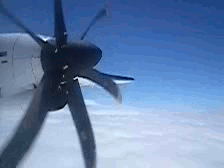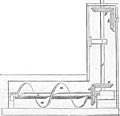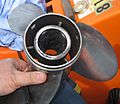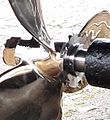Propeller facts for kids
A propeller is like a special fan that helps things move through air or water. It has two or more blades that spin very fast. These spinning blades push the air or water, creating a force that makes an aircraft, ship, or submarine go forward. Think of the blades as tiny, spinning wings!
Aircraft Propellers: How They Work
The idea for modern aircraft propellers came from the Wright brothers. Before them, some people tried to make air propellers like boat propellers. But the Wrights realized that a propeller is actually very similar to an airplane's wing. They used what they learned from their wind tunnel tests on wings to design their propellers.
They also added a special "twist" along each blade. This twist helps the blade push the air evenly along its whole length. Their first propeller blades were almost as good as the ones we use today, even 100 years later! By the 1920s, people understood a lot about how propellers work at slow speeds.
Early Propeller Designs
Alberto Santos-Dumont was another early airplane pioneer. He used his experience with airships to create a propeller for his 14 bis biplane. His design had a steel shaft and blades made of aluminum.
Some of his propeller blades were made from bent aluminum sheets, which gave them a wing-like shape. However, they were very curved and didn't have the twist that the Wright brothers used. This made them less efficient. Even so, Santos-Dumont's design was one of the first times aluminum was used to build an aircraft propeller.
Images for kids
-
An US Navy P-3 Orion's propeller being checked before flight.
-
Archimedes' screw, an ancient device that uses a rotating screw to move water.
-
The propellers of the RMS Olympic. The two outer propellers spin in opposite directions.
-
The screw propeller of the SS Archimedes.
-
A copy of the first propeller used on the SS Great Britain. A different, four-bladed propeller replaced it in 1845.
-
A broken rubber part inside an outboard engine's propeller.
See also
 In Spanish: Hélice (dispositivo) para niños
In Spanish: Hélice (dispositivo) para niños















